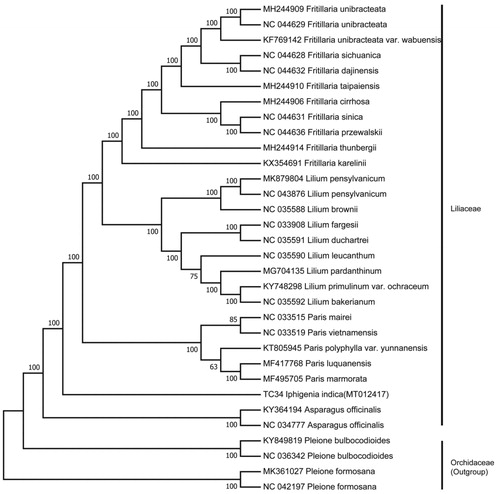Abstract
Iphigenia indica is a medicinal plant commonly used in southwest of China. In this study, we sequenced the complete chloroplast (cp) genome sequence of I. indica to investigate its phylogenetic relationship in the family Liliaceae. The total length of the chloroplast genome was 158,319 bp, with 30.6% overall GC content, a pair of IRs (inverted repeats) of 28,055 bp was separated by a small single copy (SSC) region of 16,900 bp and a large single copy (LSC) region of 85,309 bp. The cp genome contained 111 genes, including 77 protein coding genes, 30 tRNA genes, and 4 rRNA genes. The phylogenetic analysis indicated Iphigenia was closely related to Asparagus.
Iphigenia L. is a genus of the Lamiaceae family, which includes 10 species in the world. Most of them are widespread in Africa (including Madagascar), tropical Asia, Australia, Pacific Islands (New Zealand), Only one species in China is distributed in southwest China (Li and Ian Citation1994). Iphigenia indica is an ethnic medicine commonly used as asthma, gout, bronchitis, and cancer (Minru and Yi Citation2016). However, up to now for such medicinal plant, many studies have focused on describing its medicinal cultivation (Mukhopadhya and Mukhopadhyay Citation2008), chemical compositions (Shi et al. Citation2012; Lun-Xing and Yi-Ping Citation2015), Species protection (Rongping and Hanlin Citation2009), However with little involvement in its genomes, Here, we report the chloroplast genome sequence of I. indica and find its internal relationships within the family Liliaceae.
Fresh and clean leave materials of I. indica were collected from Lijiang city, Yunnan, China (N26°44′19.57″, E100°15′54.77″), and the plant materials and a voucher specimen (TC34) were deposited at Tourism and Culture College of Yunnan University (Lijiang). Total genomic DNA was extracted using the improved CTAB method (Doyle Citation1987; Yang et al. Citation2014), and sequenced with Illumina Hiseq 2500 (Novogene, Tianjing, China) platform with pair-end (2 × 300 bp) library. About 5.19 Gb of raw reads with 17,290,260 paired-end reads were obtained from high-throughput sequencing. The raw data was filtered using Trimmomatic v.0.32 with default settings (Bolger et al. Citation2014). Then paired-end reads of clean data were assembled into circular contigs using GetOrganelle.py (Jin et al. Citation2018) with Aloe vera (KX377524) as reference. Finally, the plastome was annotated by the PGA (Plastid Genome Annotator) (Qu et al. Citation2019) with manual adjustment using Geneious v. 7.1.3 (Kearse et al. Citation2012).
The circular genome map was generated with OGDRAW v.1.2 (Lohse et al. Citation2013). Then the annotated chloroplast genome was submitted to the GenBank under the accession number MT012417. The total length of the chloroplast genome was 158,319 bp, with 30.6% overall GC content, a pair of IRs (inverted repeats) of 28,055 bp was separated by a small single copy (SSC) region of 16,900 bp and a large single copy (LSC) region of 85,309 bp. The cp genome contained 111 genes, including 77 protein-coding genes, 30 tRNA genes, and 4 rRNA genes.
To investigate its taxonomic status, a total of 27 cp genome sequences of Lamiaceae species were downloaded from the NCBI database used for phylogenetic analysis. After using MAFFT V.7.149 for aligning (Katoh and Standley Citation2013), a neighbor-joining (NJ) tree was constructed in MEGA v.7.0.26 (Kumar et al. Citation2016) with 1000 bootstrap replicates and four Orchidaceae species (Pleione bulbocodioides (KY849819, NC036342), Pleione formosana (MK361027, NC 042197)) were used as outgroups. The results showed that Iphigenia was closely related to Asparagus (). Meanwhile, the phylogenetic relationship in Lamiaceae was consistent with previous studies and this will be useful data for developing markers for further studies.
Disclosure statement
No potential conflict of interest was reported by the author(s).
References
- Bolger AM, Lohse M, Usadel B. 2014. Trimmomatic: a flexible trimmer for Illumina sequence data. Bioinformatics. 30(15):2114–2120.
- Doyle J. 1987. A rapid DNA isolation procedure for small quantities of fresh leaf tissue. Phytochem Bull. 19:11–15.
- Jin JJ, Yu WB, Yang JB, Song Y, Yi TS, Li DZ. 2018. GetOrganelle: a simple and fast pipeline for de novo assembly of a complete circular chloroplast genome using genome skimming data. bioRxiv: 1–11.
- Kearse M, Moir R, Wilson A, Stones-Havas S, Cheung M, Sturrock S, Buxton S, Cooper A, Markowitz S, Duran C, et al. 2012. Geneious basic: an integrated and extendable desktop software platform for the organization and analysis of sequence data. Bioinformatics. 28(12):1647–1649.
- Katoh K, Standley D. 2013. MAFFT multiple sequence alignment software version improvements in performance and usability. Mol Biol Evol. 30(4):772–780.
- Kumar S, Stecher G, Tamura K. 2016. MEGA7: Molecular evolutionary genetics analysis version 7.0 for bigger datasets. Mol Biol Evol. 33(7):1870–1874
- Li HW, Ian CH. 1994. Lamiaceae. In: Wu ZY and Raven PH, editors. Flora of China 17th ed. Beijing: Science Press.
- Lohse M, Drechsel O, Kahlau S, Bock R. 2013. OrganellarGenomeDRAW-a suite of tools for generating physical maps of plastid and mitochondrial genomes and visualizing expression data sets. Nucleic Acids Res. 41:W575–W581.
- Lun-Xing G, Yi-Ping C. 2015. Species textual research and study on colchicines content of shancigu in lijiang of yunnan. Pharm Clin Chinese Materia. 6(3):1–3.
- Minru J, Yi Z. 2016. Dictionary of Chinese ethnic medicine Beijing: China Medical Science and Technology Press.
- Mukhopadhyay MJ, Mukhopadhyay S. 2008. A biotechnological approach for enhancement of colchicine accumulation in Iphigenia indica Kunth. J Plant Biochem Biotechnol. 17(2):185–188.
- Qu XJ, Moore MJ, Li DZ, Yi TS. 2019. PGA: a software package for rapid, accurate, and flexible batch annotation of plastomes. Plant Methods. 15:50.
- Rongping T, Hanlin S. 2009. Discussion on Endangered mechanism and conservative strategies of Iphigenia indica. Chinese Wild Plant Resources. 28(3):19–20.
- Shi Y, Yang YL, Li WY. 2012. Extraction the colchicine of Iphigenia indica in aqueous two-phase System. Natural Product Research and Development. 24(10):1412–1416.
- Yang JB, Li DZ, Li HT. 2014. Highly effective sequencing whole chloroplast genomes of angiosperms by nine novel universal primer pairs. Mol Ecol Resour. 14:1024–1031.

